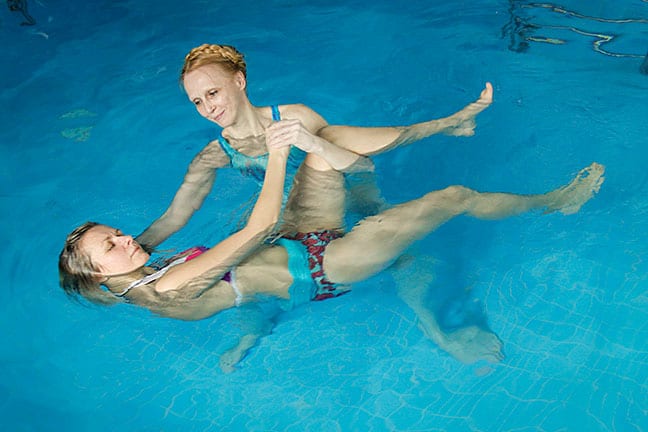The Ultimate Guide To Hydrotherapy
You may have heard the term “hydrotherapy” before – but what does it mean? Hydrotherapy is a type of alternative medicine that is used in occupational or physiotherapy, and as you guessed it, uses water in order to promote healing. The temperature of the water is important for helping the body to heal. Cold water, for example, causes the superficial blood vessels (veins close to the surface of the skin) to constrict, forcing the blood away from the surface and towards your internal organs. Hot water on the other hand, forces your superficial veins to dilate which stimulates the sweat glands and pulls away waste from the body. In addition to using temperature there are aquatic exercises and passive therapy exercises which one can perform in order to get the most out of their hydrotherapy.
Popular Aquatic Exercises
Aqua Jogging
 Aqua jogging is a method of running upright in the water and is particularly suitable for the elderly and overweight. Originally suggested for pre and post-surgery patients aqua jogging is a great way to stay in shape without having to worry about the joint stress, muscle soreness, and stress fractures that running on land can typically bring. Running in particular is a powerful cardiovascular workout because it involves the leg muscles. Aqua jogging or water running lets you enjoy all the cardiovascular benefits and is particularly useful for rehabilitating sports injuries. Normally done with a floatation belt, the iPool dual tether system can also be modified for aqua jogging, and water treadmills also work as a way to run in the water without a floatation belt.
Aqua jogging is a method of running upright in the water and is particularly suitable for the elderly and overweight. Originally suggested for pre and post-surgery patients aqua jogging is a great way to stay in shape without having to worry about the joint stress, muscle soreness, and stress fractures that running on land can typically bring. Running in particular is a powerful cardiovascular workout because it involves the leg muscles. Aqua jogging or water running lets you enjoy all the cardiovascular benefits and is particularly useful for rehabilitating sports injuries. Normally done with a floatation belt, the iPool dual tether system can also be modified for aqua jogging, and water treadmills also work as a way to run in the water without a floatation belt.
Water Dumbbell Workouts
Upper body exercises can be performed too in the water using water dumbbells or fins. Water dumbbell workouts have become more and more popular even with professional athletes because of the unique resistance properties of water. Unlike normal land based training water exercises require you to fight against the water and can be even more effective and challenging. If you are interested in learning more we have a comprehensive series of water dumbbell exercise videos and illustrated guides located here on our website.
Passive Therapy Exercises
Watsu
Watsu is a portmanteau of ‘Shiatsu’ and ‘water’, and is a type of aquatic bodywork or massage carried out in water. During a watsu session, a “receiver” – a client or patient – is aided by a “provider” – the practitioner or therapist – while in chest-deep warm water. The provider delicately stretches and massages the receiver in an effort to promote deep relaxation and physical rehabilitation.
Common exercises include:
- Accordion: the receiver draws both knees up towards the chest and then away from the chest while in coordination with a steady breathing rhythm.
- Water Breath Dance: gentle movements are made which harmonize with the natural buoyancy motion as the receiver breathes steadily.
One of our customers, Carol Cheshire, is a certified Watsu Practitioner and uses her Fitmax iPool to provide Watsu aquatic bodywork to her patients. Here is a video of her work below:
Ai Chi
First developed in Japan as a way to help people prepare for Watsu exercises, Ai Chi is a type of aquatic exercise that helps to achieve total body relaxation through deep breathing techniques and slow movements known as katas. Ai Chi is typically performed in shoulder-deep water, and uses water resistance to strengthen the body.
Hydrotherapy Benefits
So what are the benefits of hydrotherapy? It turns out, quite a bit! Whether you suffer from arthritis, swollen joints, or low energy levels, setting aside time to perform simple, low-impact exercises a few times during the week can improve your mental and physical health.
- Osteoarthritis Benefits
According to clinical rehabilitation research performed in 2018, after an eight week treatment of individuals with osteoarthritis of the knee participating in aquatic exercise twice weekly compared to a group who only received patient education regarding their condition, those who used aquatic exercise saw a noticeable improvement in terms of pain reduction and function.
- Anti-inflammatory Benefits
In a study published by the International Journal of Rheumatic Diseases in 2017, scientists found that the participants who suffered from rheumatoid arthritis and took part in hydrotherapy in addition to using conventional medication saw an increase in their antioxidant levels as well as improved oxidative stress levels.
- Cancer Benefits
68 women who were treated for early-stage breast cancer were asked to either participate in an eight-week, hour-long aquatic exercise program or continue following their doctor’s regular orders in a study published in the Archives of Physical Medicine and Rehabilitation. Those who took part in the water exercise program felt less exhaustion after their workouts than before.
Cancer treatment is intensive and oftentimes it can cause patients to suffer from chronic pain and weight gain, which can in turn decrease cardiovascular strength and quality of life. Aquatic rehabilitation and exercise are becoming more and more popular for handling the complications and side effects that are so common with cancer treatment. For example, lymphedema is a condition frequently caused by certain cancers. It is typically characterized by swelling due to excess fluids collecting in tissue. While the condition is not curable, aquatic therapy has been proven to be a safe method for helping to circulate lymph fluid and therefore reducing swelling and pain.
- Diabetes Benefits
People with both type 1 and type 2 diabetes must be very cognizant of their blood sugar levels and do their best to manage hyperglycemia, or high blood sugar. Exercising in water has been found to help lower blood sugar levels, as well as improve cholesterol levels, blood pressure, and overall body composition. Check out our handy infograph here for some astonishing facts:

Healing Properties of Water
It’s well known that compression is great for relieving pain by applying pressure to an affected area in order to increase blood circulation. If you’re not familiar with Archimedes’ principle, it states that an object submerged in water will displace a volume of water that is equal to its own volume. It’s this displacement that creates pressure, and what makes hydrotherapy such a great source of pain relief!
If you swear by the pain relief offered by compression stockings or gloves, why not then do something that can provide more compression and therefore more effectively ease your pain? In terms of pressure metrics, typical store-bought compression stockings offer about 8mmHg of pressure, but by immersing yourself in just three feet of water, you can experience up to 72mmHg and greatly reduce painful swelling!
 Did you know that water is 800 times more dense than air? When a body is immersed in water up to the pelvis, roughly 40% of that body weight is essentially removed. When you submerge a body up to the sternum, that percentage increases to about 60-72%. By offloading a large portion of the body’s mass, swollen, weak, or painful joints and injured limbs can enjoy the benefits of supporting a less cumbersome weight. This relief compared with the natural buoyancy offered by water lets people suffering from chronic pain conditions such as arthritis to perform exercises with much less impact and more ease.
Did you know that water is 800 times more dense than air? When a body is immersed in water up to the pelvis, roughly 40% of that body weight is essentially removed. When you submerge a body up to the sternum, that percentage increases to about 60-72%. By offloading a large portion of the body’s mass, swollen, weak, or painful joints and injured limbs can enjoy the benefits of supporting a less cumbersome weight. This relief compared with the natural buoyancy offered by water lets people suffering from chronic pain conditions such as arthritis to perform exercises with much less impact and more ease.
Hydrotherapy is a safe, time-tested form of treatment that can provide healing, improved wellbeing, and allow participants to develop their strength and fitness in a calming, low-impact environment. Aquatic exercises can be easily tailored to an individual’s needs, whether it be for general pain and stress relief, or more chronic issues such as arthritis or complications brought on by cancer treatment.
If you are interested in home hydrotherapy, there are various options available such as swimspas and portable therapy pools like our Fitmax iPool. You can savor a hot soak or perform a variety of exercises on your own or using one of many available accessories, including aquatic bicycles, water dumbbells, and aquatic treadmills that are designed to be fully submerged in water. No matter what you choose hydrotherapy offers incredible healing properties and no longer requires driving to a specialized treatment center or local recreation center to enjoy.
References



